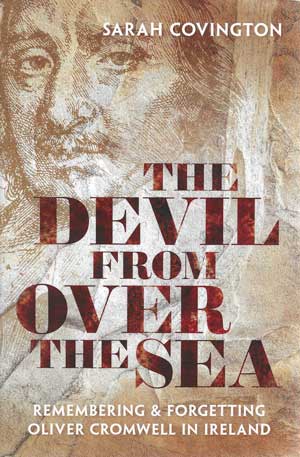The Devil from over the Sea: Remembering and Forgetting Oliver Cromwell in Ireland
Published in Book Reviews, Book Reviews, Issue 5 (September/October 2022), Reviews, Volume 30SARAH COVINGTON
Oxford University Press
£25
ISBN 9780198848318
Reviewed by Guy Beiner
Guy Beiner is the Sullivan Chair of Irish Studies at Boston College.
In the Irish countryside, a hex of ‘scrios Cromaill ort’ (typically cast by an elderly woman or a widow) was dreaded. The ‘Curse of Cromwell’ conjured up deep-rooted and traumatic historical memories, that had been transmitted, re-adapted and repeatedly transformed over three and half centuries. Taking upon herself the monumental task of tracing this elusive history of remembering and forgetting in all its many facets and myriad appearances ‘across the religious, political, literary, economic, material and folkloric spectrum’—from the time of the events to the present day, Sarah Covington has uncovered hundreds of allusions to the legacy of Cromwell’s campaign in Ireland and the Cromwellian settlement, effectively excavating one of Ireland’s most pervasive lieux de mémoire.
Although ‘there were many recollections of Cromwell’s military campaign and accounts of massacre, bodily destruction, famine, plague, and religious divide’, it turns out that ‘in the long run Cromwell’s most enduring legacy resided in the regime’s transformation of Ireland’s ownership terrain’ (p.163). The official cartography of the Civil Survey and William Petty’s Down Survey was designed to legitimise land confiscations and efface memories of previous ownership, yet family traditions, genealogies and placenames subversively contested this displacement, sustaining burning desires for retribution that fed into agrarian agitation and were subsequently harnessed for the cause of nationalism. Embittered memories travelled with Irish immigrants across the globe. Covington reveals that in the United States, nineteenth-century Carlylean admiration of Cromwell in the mainstream press was challenged by Irish-American writers and orators who referenced Cromwell as a foundation myth of dispossession that preceded the Great Famine.
The ruins left by the devastation of the Cromwellian campaign across Ireland defied facile romanticization and were ‘reinvented with each generation’ (p. 219). These sites could subsume memories of other calamities, as Cromwell and his henchmen became a catch-all signifier for colonial violence. Given the sectarian nature of the conflict, memories of Cromwell inevitably had a religious character, epitomized by traditions of hoofprints in churches, despoiling the holy ground. The Catholic martyrologies of the seventeenth century were subdued in the eighteenth century, only to be revived and embellished in the nineteenth century, eventually leading to the canonization of the martyrs of Drogheda and Wexford. Covington is to be praised for also looking beyond the more familiar terrain of Catholic memory and examining Protestant traditions. Wedged in between loyalist commemorations of the 1641 Rebellion and of William of Orange, Cromwell was long overshadowed and marginalized, yet Church of Ireland Anglicans, and even more so Presbyterians, preserved ambiguous recollections of an awkward history (to be truculently reclaimed by Ian Paisley).
Cultural memory is apparent in many obscure works of popular print. It also crops up in the writings of W.B. Yeats, James Joyce and even more prominently in Brendan Kennelly’s 1983 poetry collection titled Cromwell. But the most evocative aspect of Covington’s book is her masterly study of ‘folkloric Cromwell’, which makes extensive use of the manuscripts of the National Folklore Collection.
Second only to Daniel O’Connell in the volume of oral traditions associated with a historic figure, the Lord Protector is utterly transformed in béaloideas through a variety of vernacular genres. He appears with a copper nose alongside Beelzebub in mumming performances, brazenly proclaiming that here ‘comes I, Oliver Cromwell … I’ve conquered many a nation’. In folk tales documented in the early-mid twentieth century, Cromwell is a former shoemaker and evolves into the devil’s servant, or the devil himself. Stories often opened with ‘Cromwell cleared the road before him’, though his reputation for maleficence was relativized though sayings that variated on a template of ‘Cromwell was bad but [some other vice] was worse’. A questionnaire issued by the UCD Folklore Department in 2010s showed that traditions of Cromwell have persisted into the new millennium.
The ingenuity of how the enduring memory of Cromwell could be utilized and re-politicized in changing contexts is best typified in the story behind the founding of the Ráth Cairn Gaeltacht in County Meath: on 29 March 1934 a delegation from Connemara travelled by bicycle to Dublin to meet with Eamon de Valera and stake a claim with the Land Commission, declaring ‘Abair leo, gur chuir Cromwell siar muid agus anois go bhfuil muid ag teacht aniar’ [‘Tell them Cromwell sent us there and now we are coming home’]. De Valera, who in 1921 had frustrated Lloyd George with a ‘long lecture on the wrongs done to Ireland starting with Cromwell’, was caught at his own game.
Covington displays a remarkable command of historiography and theory. The analysis, while always well informed and insightful, falls short of drawing generalizations that can be applied to memory studies elsewhere and is not strong on making comparative analogies (references in the concluding pages to 1789, 1917, Napoleon, or the Hungarian defeat to the Ottomans on the battlefield of Mohacs in 1526 require further thought). Nonetheless, this is an exemplary historical study of Irish social memory.

















